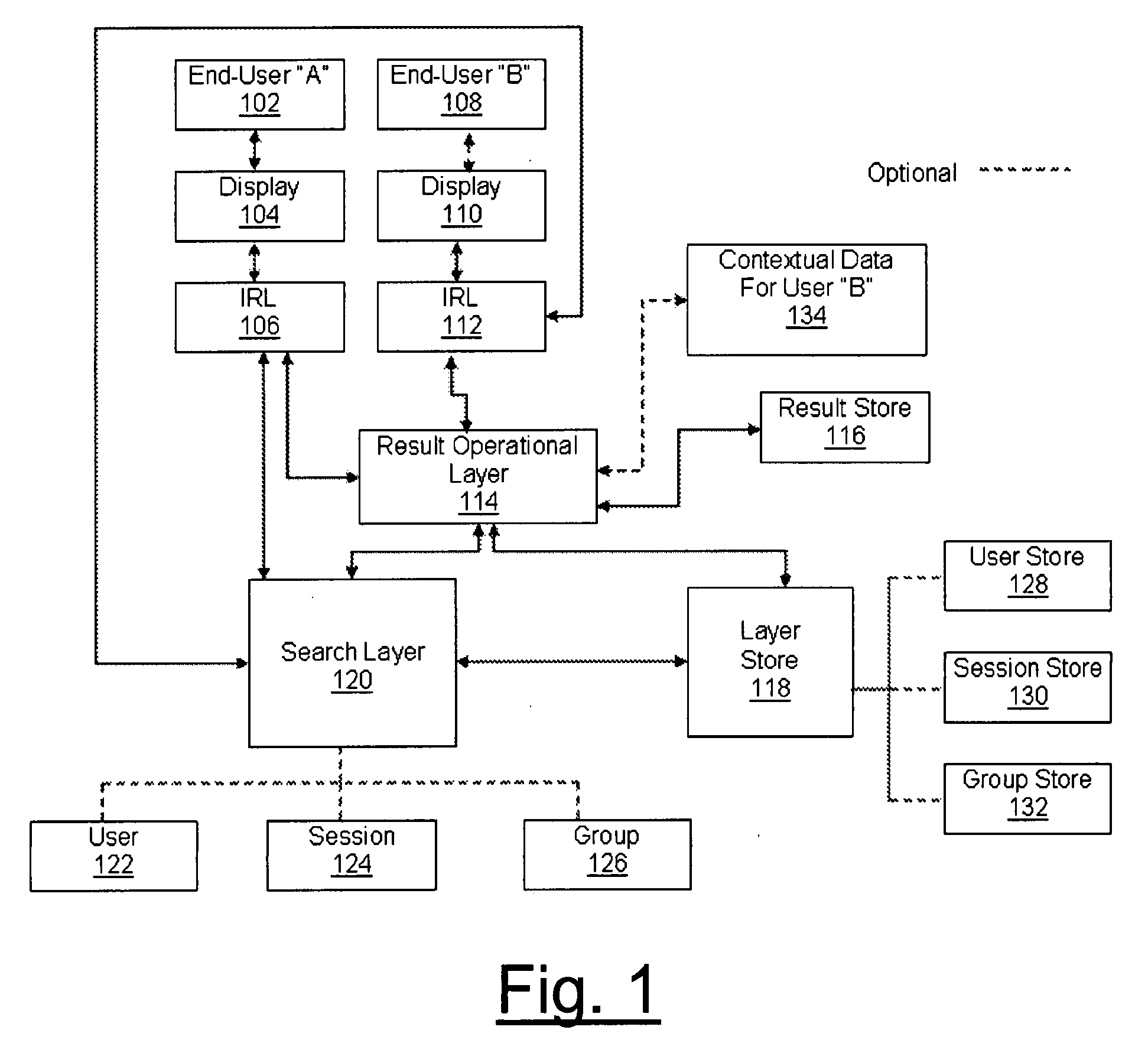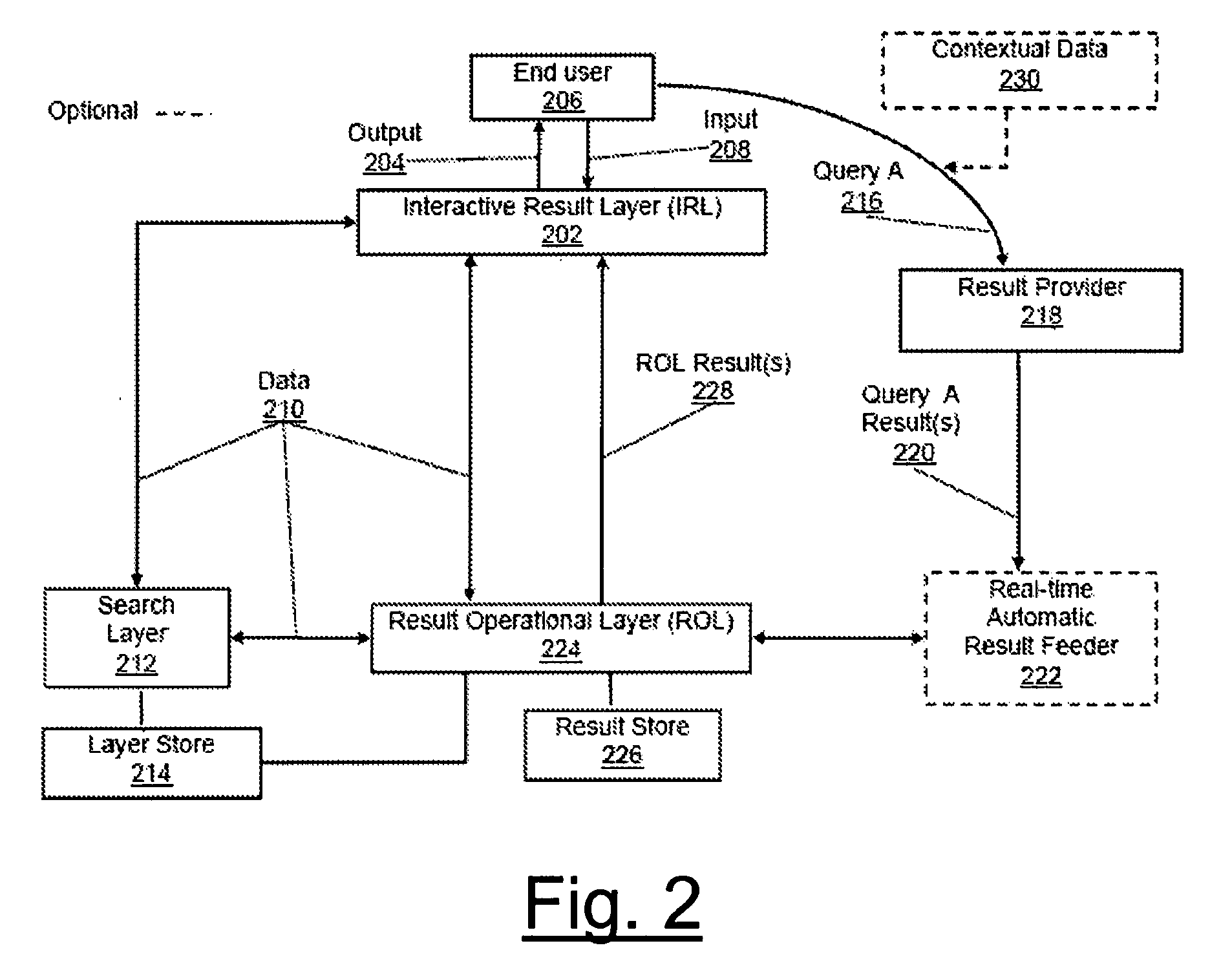As search systems increase in size and complexity, queries tend to generate more results than the typical information seeker can effectively go through to find the best or desired results.
Furthermore, as
electronic data transfer and communication become more complex, there are more items that can be searched using computer-implemented methods.
The application of many search systems can also produce more
noise, and the process may require more time and energy for the end-user to conduct search.
Such searches generally do not allow for further refinement of items though interactions, such as “delete”.
While current “saved” search is most suitable for systems with only one goal, such as finding property or a vehicle, it is not practical in situations where the relationship of items searched to the intent of query issued is only easily known by the end-user issuing the queries.
Saving the queries alone is not as helpful to the end-user who might be evaluating a wide range of items whose relevance is only truly deciphered by the end-user.
Current search systems are limited to query-based sessions, which do not allow the incorporation of influence of multiple, seemingly disparate queries aimed at the same purpose or project.
In other words, current search systems fail to capture
user intent outside of queries issued.
While actual keywords in queries are vital in knowing the
subject matter of the search, they do not necessarily capture the intent or larger goals of the queries.
Seemingly different queries (e.g., different keywords) are not able to work in conjunction to optimize and refine search.
These methods are tied to the result provider itself and ultimately can only produce one
result set to the string of queries.
However, these often rigid, pre-structured query sessions limit the freedom of the end-user to link queries by how she intends the queries to be associated.
Organizing search results based on query alone is insufficient to ensure that a particular result meets the intention of said end-user.
Furthermore, if a third query is issued without any similar keywords, such as “Catholic Church”, the end-user is not able to link this query with either of the previous two.
Storing information based on query alone will not capture end-user's intent.
Deleting such files could present problems to other users who might require access to those same files.
Aware Search does not control what interactions the new user can then perform on that data, neglecting possible hierarchies in the collaborating relationship.
Furthermore, Aware Search does not facilitate near real-
time sharing of data nor is the
system “socially aware”.
The problem with such common methods of social context is social relationships are “inferred” based on the common relationship to a particular item in the search rather than the social contexts in which the end-user truly finds herself situated.
These systems do not take into account commonalities the end-user values or the degree of trust the end-user has or established with other particular users.
For query systems that cater to many end-users, a group of three hundred commenting on an item can become overwhelming for a particular end-user and not particularly useful.
For example, a
system that allows users to rate the “value” of a comment or item does not necessarily cater to the whole
population of users in a given
community.
Current systems do not necessarily capture the needs of some individual end-users who do not fall in the “norm”.
A group lens additionally provides people the ability to swarm around content people are providing to the group; however, they do not provide a search system that integrates the established “lens”.
The problem with this approach is many voices are left out or edited out.
This approach is not practical for closed or private forums where search holds sensitive information.
However, in areas she is not sure the expertise of her network, she might prefer exploring items from users unknown to her.
The filter may be of value; however, this approach cannot use social filters for every query and cannot be applied to all content.
Systems that view each member as equal or establish a universal rank among all members do not capture effectively the relationships each member of the group has in relation to said group or
community.
For example, this type of egalitarian search system cannot be applied within an elementary school
community consisting of young students, teachers, and administrators where members have different responsibilities, discernment, interest, etc.
While
nodal relationships can be made and maintained, self-identified groups are not able to share, collaborate, or inform extensively as a group within the search environment itself.
Furthermore, even among limited “communities” that have shared commonality, such as those that have similar political interests, hobbies, or backgrounds, the greater commonality of the aggregate as a whole is given priority and results provided do not cater to the particular end-user.
Current search systems are meant to be informative but they are not necessarily material to the overall end-user experience.
Currently, the end-user has limited control over the social context in which searches are conducted prior to the
initiation of each query or in the process of a query session in the case of persistent queries.
Most search systems cannot accommodate group-based search where the queries are generated for the purpose of providing information for group use.
Current systems and methods for group-informing searches have been limited in scope.
While many explicit social searches may help inform the end-user's personal search, explicit search does not necessarily facilitate the common goals of a group of known end-users.
While
nodal relationships can be made and maintained in current explicit “social” search models, self-identified groups are not able to share, collaborate, or inform extensively as a group within the search environment itself.
In other words, the priority in explicit systems is placed on the end-user, but does not allow extensive group-based awareness outside of the
nodal relationships of the community as a whole.
This method does not allow for many people to swarm around information during a search to maximize
use of time and utilize more people's expertise to aid evaluation of items, especially in a working group environment.
However, Technorati's hierarchical system only applies to the content provider's imposed hierarchical system and not the searchers'.
In the school example, content providers can rate appropriateness of material, and filters can block material rated inappropriate or permit access to material rated appropriate; however, these filters
blanket the entire system.
Teachers who might want to incorporate additional filters to aid her students on a particular project cannot isolate particular items for said search independent of the system as a whole.
In other words, filters are not able to be tiered seamlessly within a search system based on the various hierarchical levels represented in the school.
While some current technological approaches try to recognize the end-user as part of “real” social networks, these systems tend to only focus on peer-to-peer relationships, content, or aggregated communities as a whole.
In other words, these search systems do not take into account end-users wanting to be identified as members of a group, conducting searches for the purpose of the group, each having a certain status within that group.
However, multiple channels cannot be integrated by the end-user with additional query criteria.
The channel itself cannot facilitate multiple different types of queries within the channel to provide results outside the channel.
Blinkx's channel system is not seamlessly integrated to allow end-users to explicitly drive
search intent further.
In other words, end-users are not able to choose how actual results should be related outside of “explicit query” or even “implicit” query”.
Overuse of
artificial intelligence takes away the freedom of end-users to conduct search for their own unique purposes.
While the good intention of intelligence is to streamline search for the end-user by narrowing results that might better match intention, these systems fail to allow end-users to input more evaluations on
search intent outside of “queries” and artificial interpretations of
search intent.
These query systems, however, have not been fully integrated with search to allow users to interact with results more fully.
However, the end-user is not able to receive evaluations on particular restaurants based on other users without visiting a website possibly devoted to such.
Even if such information could be retrieved, a small display would not be able to
handle possibly thousands of comments.
The data on results are currently not integrated in a way that can provide useful data based on social intelligence as well.
Although these technologies are novel, such as
barcode readers on phones, their uses are limited to quick, simple content, as more complex queries would take a long time to sort through information.
Although Yahool Local integrates many queries into one interface, i.e. map query,
web page query, user's comments, these mash-ups to not provide integrated
collective intelligence and contextual intelligence.
Yahoo Local provides context, but the context is not socially aware or contextually aware of the end-user.
He might want a local pizza establishment with a “sports feel” or where sport enthusiasts go, but is not familiar with the area.
Currently, these types of preferences to refine search cannot be captured through queries.
Currently, there is no method to capture such context that can be used directly by the end-user so as to better present results he might prefer.
 Login to View More
Login to View More  Login to View More
Login to View More 


